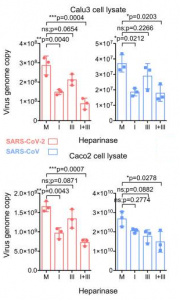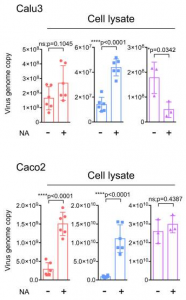A group from The University of Hong Kong etc. has reported on the effects of heparan sulfate and glycan modification of ACE2 in the infection of the new coronavirus (SARS-CoV-2).
https://www.nature.com/articles/s41467-020-20457-w
Calu3 (lung epithelial cells) and Caco2 (intestine epithelial cells) are used in SARS-CoV-2 infection experiments. Heparinase was used to investigate the effects of heparan sulfate, and Neuraminidase (NA) was used for the effects of ACE2 glycan modification, with a particular focus on sialic acid.
As shown in the figure below, heparinase suppresses viral infection and shows that heparan sulfate is involved in the capture of the virus as a co-receptor for ACE2. For the sialic acid modification of ACE2, it is shown that the infection of the virus is rather stronger by cleaving the sialic acid with NA.


